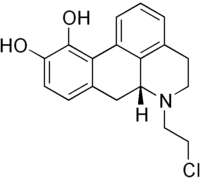Chloroethylnorapomorphine

| |
| Names | |
|---|---|
| IUPAC name 12a-Chloro-12a-homo-6aβ-aporphine-10,11-diol | |
| Systematic IUPAC name (6aR)-6-(2-Chloroethyl)-5,6,6a,7-tetrahydro-4H-dibenzo[de,g]quinoline-10,11-diol | |
| Other names (−)-N-(2-Chloroethyl)-norapomorphine | |
| Identifiers | |
3D model (JSmol) |
|
| ChEMBL | |
| ChemSpider | |
PubChem CID |
|
| UNII | |
CompTox Dashboard (EPA) |
|
| |
| |
| Properties | |
| C18H18ClNO2 | |
| Molar mass | 315.80 g·mol−1 |
Except where otherwise noted, data are given for materials in their standard state (at 25 °C [77 °F], 100 kPa). | |
Chloroethylnorapomorphine is a chemical once thought to be an irreversible dopamine D2 receptor antagonist;[1][2] however, it was later proved to be reversible.[3]
References
- ^ Cohen SA, Neumeyer J (Oct 1983). "Kinetics of solvolysis of N-(2-chloroethyl)norapomorphine, an irreversible dopamine receptor antagonist". Journal of Medicinal Chemistry. 26 (10): 1348–53. doi:10.1021/jm00364a003. PMID 6620296.
- ^ Guan JH, Neumeyer JL, Filer CN, Ahern DG, Lilly L, Watanabe M, Grigoriadis D, Seeman P (Jun 1984). "N-(2-chloroethyl) [8,9-2H]norapomorphine, an irreversible ligand for dopamine receptors: synthesis and application". Journal of Medicinal Chemistry. 27 (6): 806–10. doi:10.1021/jm00372a019. PMID 6737423.
- ^ Lehmann, J; Langer, SZ (1982). "Dopamine autoreceptors differ pharmacologically from postsynaptic dopamine receptors: Effects of (−)-N-(2-chloroethyl)-norapomorphine". European Journal of Pharmacology. 77 (1): 85–6. doi:10.1016/0014-2999(82)90542-8. PMID 7060630.
